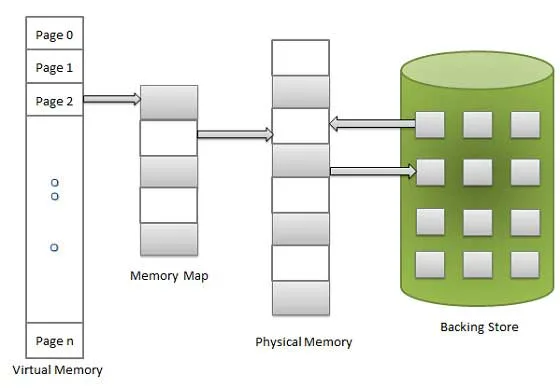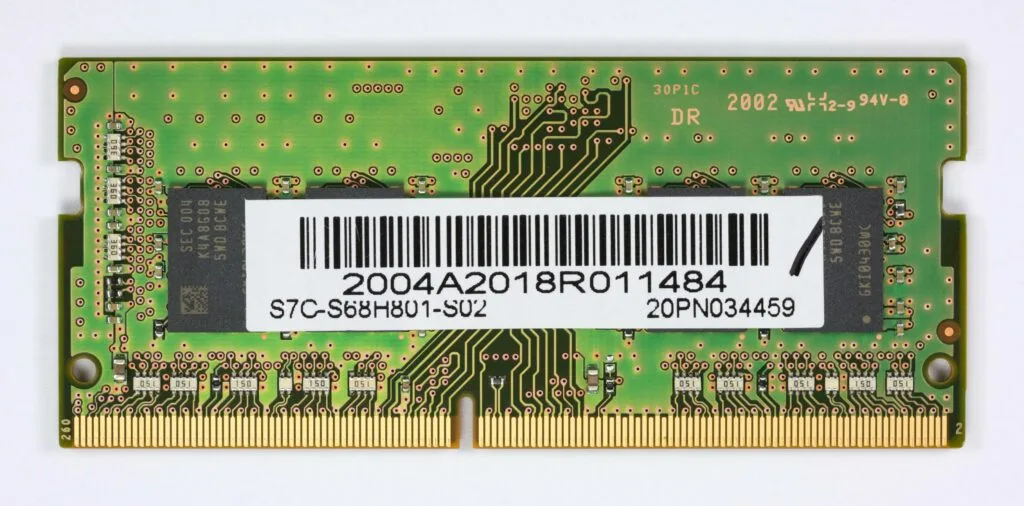This website may contain affiliate links, which means I may receive a commission if you click on a link and make a purchase. While clicking on these links won't cost you any extra money, they will help me keep this site up and running. Your support is appreciated!
Have you ever wondered how your computer manages to run multiple programs at the same time, without crashing or slowing down? It’s all thanks to a little thing called virtual memory and a handy helper called the swap file. In this article, we’re going to dive into the world of virtual storage and explain how these two crucial components work together to keep your computer running smoothly. So grab a cup of coffee and get comfortable, because we’re about to demystify the magic behind virtual memory and swap files.
Table of Contents
- What is Virtual Memory?
- Introducing the Swap File
- Why Do We Need Virtual Memory?
- Managing Swap Space on Your Hard Drive
- Monitoring Virtual Memory Usage
- Adjusting the Size of Your Swap File
- Troubleshooting Issues with Swap Files
- Best Practices for Configuring Virtual Memory
- Comparing Swap Partitions vs Swap Files
- Alternatives to Using a Swap File
- Questions & Answers for Virtual Memory and Swap File Explained
- Closing Remarks
What is Virtual Memory?
Virtual memory is a crucial aspect of computer systems that allows them to compensate for physical RAM limitations. It essentially expands the available memory by storing data on the hard drive, which requires less expensive physical memory. This allows the system to run multiple applications simultaneously without running out of memory.
Virtual memory provides several benefits, such as:
- Increased multitasking capabilities: With virtual memory, the system can juggle multiple tasks at once without experiencing significant slowdowns or resource shortages.
- Efficient memory allocation: The system can dedicate more memory to demanding applications without the need for expensive hardware upgrades.
- Improved system stability: Virtual memory helps prevent crashes and system errors by preventing memory overloads.
Swap files are the physical files on the hard drive where virtual memory is stored. When the system runs out of physical memory, it can offload some of the data to the swap file to free up space for other tasks. However, excessive use of swap files can lead to decreased performance due to slower access times compared to physical RAM. It’s important to carefully manage swap file usage to avoid performance issues.
When it comes to managing virtual memory and swap files, it’s essential to strike a balance between using them efficiently and avoiding over-reliance. To optimize virtual memory, consider the following tips:
- Adjust virtual memory settings: Increase the size of the swap file to ensure that the system has enough space to handle demanding tasks without resorting to extreme memory management.
- Monitor swap file usage: Keep an eye on how much virtual memory the system is using and consider upgrading physical memory if swap file usage becomes excessive.
- Manage system resources: Limit the number of background processes running to minimize the need for virtual memory and improve overall system performance.
By understanding the role of virtual memory and swap files, users can make informed decisions about managing system resources and optimizing performance for their specific needs.
Introducing the Swap File
The swap file, also known as the page file, is a crucial component of virtual memory management in modern operating systems. It serves as an extension of physical RAM, allowing the system to use hard drive space to store data that would otherwise reside in RAM. This is especially useful when physical memory is limited, as it allows the system to continue running efficiently even when all available RAM is in use.
In essence, the swap file is a safety net for when the physical memory is exhausted, and the system needs to offload some data to keep running smoothly. When this happens, unused data is moved from RAM to the swap file, freeing up space in physical memory for other processes. When the data is needed again, it can be swapped back into RAM from the swap file.
The size of the swap file is an important consideration, as it directly impacts the system’s performance. It should be large enough to accommodate the data that needs to be swapped out of RAM, but not so large that it negatively affects disk space or performance. Typically, the swap file is automatically managed by the operating system, but advanced users may choose to manually configure the size of the file.
In summary, the swap file is a critical part of virtual memory management, allowing the system to maximize the use of physical memory and run more efficiently. Without it, the system would be much more limited in its capabilities, especially when it comes to running multiple applications simultaneously.
Why Do We Need Virtual Memory?
Virtual memory is crucial for running multiple programs on a computer efficiently. When the physical RAM is full, the operating system uses virtual memory to store data that isn’t immediately needed. This allows the system to continue running smoothly without crashing or slowing down. But why do we need virtual memory in the first place?
Multi-tasking: Virtual memory allows us to run multiple programs at the same time without overloading the physical RAM. This is essential for productivity and convenience, especially for people who use their computers for work or school.
Memory management: Virtual memory helps the operating system manage memory resources effectively. It ensures that each program gets the memory it requires, without causing conflicts or crashes.
Demand paging: Virtual memory uses a technique called demand paging, which only brings data into the physical RAM when it’s needed. This helps conserve memory and prevents unnecessary data from occupying valuable space.
Swap file: Virtual memory uses a swap file as a storage area on the hard drive to temporarily store data that’s not being used. This allows the system to free up physical RAM for more important tasks, without losing any data.
Virtual memory is essential for the efficient operation of modern computer systems. It allows us to run multiple programs simultaneously, manages memory resources effectively, and ensures smooth performance. The use of a swap file further enhances the capabilities of virtual memory, making it an indispensable component of modern computing.
Managing Swap Space on Your Hard Drive

When your system’s physical RAM is full, virtual memory comes into play by utilizing a dedicated portion of your hard drive as additional RAM. This process is crucial for keeping your system running smoothly and preventing crashes due to lack of memory. To manage your swap space efficiently, follow these simple steps:
Check your current swap space: To see how much swap space is currently being used, open your terminal and use the ”free -m” command. This will display the total swap space available, used, and free on your system.
Adjust swap space size: If you find that your system is utilizing swap space too frequently, it may be necessary to adjust the size of your swap file. This can be done by creating a new swap file with the desired size and enabling it. Keep in mind that the size of your swap file should ideally be at least equal to the amount of physical RAM on your system.
Optimize swap space usage: To optimize the usage of your swap space, prioritize keeping your system’s physical RAM as clear as possible. Close unnecessary applications and background processes to free up memory, and consider adding more physical RAM if you frequently find your system utilizing swap space.
Consider using a swap partition: Instead of a swap file, you may opt to create a dedicated swap partition on your hard drive. This can potentially improve performance compared to a swap file, as it allows for direct access to the swap space.
By effectively managing your virtual memory and swap file, you can ensure that your system runs smoothly and efficiently, even when under heavy load. Keep an eye on your system’s swap space usage and adjust as necessary to maintain optimal performance.
Understanding and managing your swap space is essential for maintaining a healthy and responsive system. Whether you choose to adjust the size of your swap file or create a dedicated swap partition, being proactive about managing your virtual memory can make a significant difference in your system’s performance.
Monitoring Virtual Memory Usage

Virtual memory is an important aspect of your computer’s performance, and monitoring its usage is crucial to ensure smooth operations. By keeping an eye on virtual memory usage, you can prevent slowdowns and crashes, and ensure a better overall user experience.
Here’s how you can monitor virtual memory usage on your system:
Use Task Manager: For Windows users, Task Manager is a handy tool for . Simply open Task Manager, select the Performance tab, and then click on Memory. Here, you can view the current virtual memory usage, as well as other memory-related information.
Check Activity Monitor: Mac users can monitor virtual memory usage using the Activity Monitor. Open Activity Monitor, click on the Memory tab, and you’ll find a wealth of information about your system’s memory usage, including virtual memory.
Monitor Swap File Usage: The swap file, also known as the page file, is an important component of virtual memory management. By monitoring swap file usage, you can gain insights into how your system is utilizing virtual memory.
Set Up Alerts: Consider setting up alerts for virtual memory usage to get notified when it reaches a certain threshold. This can help you proactively address any memory-related issues before they impact your system’s performance.
By regularly and staying on top of any potential issues, you can ensure a smoother computing experience. Whether you’re a casual user or a power user, keeping an eye on virtual memory and swap file usage can make a difference in your system’s performance.
Adjusting the Size of Your Swap File
So, you’ve learned about virtual memory and the role of the swap file in managing it. Now, let’s talk about how to adjust the size of your swap file to optimize your system’s performance. It’s important to note that the swap file size should be at least as large as the amount of physical RAM in your computer, and ideally, it should be 1.5 to 2 times the amount of RAM for optimal performance.
Here’s how to adjust the size of your swap file to ensure your system runs smoothly:
Check Your Current Swap File Size:
- Open the Control Panel and go to System and Security. Click on System, then click on Advanced system settings. Under the Advanced tab, click on Settings in the Performance section.
- Click on the Advanced tab, then click on Change in the Virtual memory section.
- Here, you’ll see the currently allocated size of your swap file. Take note of this before making any changes.
- Adjusting the Swap File Size:
- To adjust the size of your swap file, click on the Custom size option.
- Enter the initial and maximum size for your swap file. Remember, the recommended size is 1.5 to 2 times the amount of physical RAM in your system.
- Click Set, then OK to apply the changes.
- You may need to restart your computer for the changes to take effect.
Remember, adjusting the size of the swap file can have a significant impact on your system’s performance, so it’s important to monitor your system after making changes to ensure everything is running smoothly. If you find that your system is still experiencing performance issues, consider increasing the size of your swap file to see if that helps.
Conversely, if you find that your system is running fine with a smaller swap file, you may be able to reduce its size to free up disk space. Keep in mind that having too large of a swap file can also take up valuable disk space, so finding the right balance is key.
Troubleshooting Issues with Swap Files
When experiencing performance issues with your computer, troubleshooting issues with your swap files is an essential step to consider. Swap files play a crucial role in managing virtual memory, and understanding how they work can help you improve your system’s performance.
Here are some common issues with swap files and how to troubleshoot them:
- Low Disk Space: If your system is running low on disk space, it can affect the performance of your swap files. To troubleshoot this issue, you can try freeing up disk space by deleting unnecessary files or moving them to an external storage device.
- Incorrect Swap File Size: The size of your swap file can impact your system’s performance. If the swap file is too small, your system may experience slowdowns, while a swap file that’s too large can waste disk space. To troubleshoot this issue, you can adjust the size of your swap file based on your system’s requirements.
- Fragmented Swap File: A fragmented swap file can lead to performance issues. To troubleshoot this problem, you can run a disk defragmentation tool to optimize the placement of data on your hard drive, including your swap file.
- Old or Corrupted Swap File: Over time, swap files can become corrupted or outdated, leading to performance issues. To troubleshoot this issue, you can recreate your swap file by disabling it, deleting the existing file, and then re-enabling it. This can help resolve any corruption or performance issues with your swap file.
By troubleshooting these common issues with swap files, you can optimize your system’s virtual memory and improve its overall performance. Keep in mind that while swap files can improve performance, they may not be a cure-all solution for all performance issues. It’s important to consider other factors that can affect your system’s performance, such as hardware limitations and software conflicts.
Best Practices for Configuring Virtual Memory

When it comes to configuring virtual memory, there are certain best practices that can help optimize your system’s performance and ensure smooth operation.
Here are some key tips for configuring virtual memory and swap file settings:
Determine the right size: It’s important to allocate the appropriate amount of virtual memory for your system. Keep in mind that setting it too low can result in sluggish performance, while setting it too high can waste valuable disk space.
Set a custom size: While it’s possible to let Windows automatically manage the size of the virtual memory, configuring a custom size can often lead to better performance. Try setting the initial size to 1.5 times the amount of physical RAM, and the maximum size to 3 times the amount of RAM.
Choose the right drive: It’s generally recommended to place the swap file on the fastest drive available, such as an SSD. This can help improve performance, as the swap file is accessed frequently during system operations.
By following these best practices for configuring virtual memory and the swap file, you can ensure that your system is running at its best. Remember that every system is different, so it may take some trial and error to find the optimal settings for your particular setup. With a little experimentation, you can find the right configuration that will keep your virtual memory running smoothly.
Comparing Swap Partitions vs Swap Files
When it comes to managing virtual memory on your computer, you have two options: swap partitions and swap files. Both serve the same purpose of providing extra memory when your system runs out of physical RAM, but they differ in terms of flexibility and ease of use.
Swap Partitions:
- A separate section of your hard drive is dedicated to the swap partition.
- It is created during the initial installation of the operating system and cannot be easily resized without repartitioning the entire drive.
- Because it is a separate partition, the system can access it directly without any additional overhead.
- It is generally considered more efficient than swap files, especially on traditional hard drives.
Swap Files:
- A swap file is a dedicated file on your system’s storage device that acts as virtual memory.
- It can be created, resized, and deleted easily, without the need to repartition the drive.
- Since it is just a file, it adds a layer of overhead because the system has to access it through the file system.
- Swap files are more convenient for systems with limited storage space or for users who want the ability to adjust their virtual memory allocation easily.
In terms of convenience and flexibility, swap files are the clear winner. They can be created and resized without much hassle, making them a great choice for systems with changing memory needs. On the other hand, for systems where efficiency is a priority, swap partitions may be the better option.
Ultimately, the decision between swap partitions and swap files depends on your specific system requirements and preferences. Consider factors such as the type of storage device, the amount of available space, and the need for flexibility when making your choice.
Alternatives to Using a Swap File
When it comes to virtual memory and managing your swap file, there are a few alternatives to consider that can help optimize your system’s performance.
Here are some options to explore:
Increase RAM: One of the most effective ways to reduce the need for a swap file is to add more physical RAM to your computer. This can help to minimize the reliance on virtual memory and improve overall system performance.
Use SSD storage: Utilizing Solid-State Drives (SSDs) can also help to reduce the need for a swap file, as SSDs are much faster than traditional hard disk drives. This can lead to quicker access to virtual memory, minimizing the impact on system performance.
Adjust virtual memory settings: You can manually configure the virtual memory settings on your computer to better suit your specific needs. By adjusting the initial size and maximum size of the virtual memory, you can optimize its performance and reduce the reliance on a swap file.
Close unnecessary applications: Another simple way to minimize the need for a swap file is to close any unnecessary applications or processes running on your computer. This can free up physical memory and reduce the need for virtual memory, improving overall system performance.
Implementing these alternatives can help to reduce the reliance on a swap file and optimize your virtual memory usage. By considering these options, you can improve the overall performance of your computer system and enhance your user experience.
Questions & Answers for Virtual Memory and Swap File Explained
What is virtual memory?
Virtual memory is a memory management capability of an operating system that uses hardware and software to allow a computer to compensate for physical memory shortages by temporarily transferring data from random access memory (RAM) to disk storage.
How does virtual memory work?
When the computer runs out of RAM, the operating system swaps data to the virtual memory on the disk, freeing up RAM for other processes. This prevents the system from crashing due to lack of memory.
What is a swap file?
A swap file, also known as a paging file, is a designated space on a hard drive that the operating system uses as virtual memory when there’s not enough physical RAM available.
How does a swap file relate to virtual memory?
A swap file is part of the virtual memory system, serving as an extension of physical memory – it’s where the operating system can temporarily store data that needs to be moved out of RAM.
How do I know if my computer is using virtual memory?
You can check your virtual memory usage through your computer’s task manager or activity monitor. If you notice a significant amount of hard drive activity or swapping, it’s likely that virtual memory is being utilized.
Can I adjust the virtual memory settings on my computer?
Yes, virtual memory settings can typically be adjusted through your operating system’s settings. You can increase or decrease the size of the swap file or let the operating system manage it automatically.
What are the benefits of virtual memory?
Virtual memory allows computers to run more applications simultaneously, even if they don’t have enough physical RAM to support them all at once. It also prevents system crashes by providing a backup memory storage space.
Are there any downsides to using virtual memory?
Using virtual memory can slow down your computer’s performance, since accessing data in the swap file on the hard drive is much slower than accessing it from RAM. Excessive use of virtual memory may lead to a noticeable decrease in speed.
Is it possible to disable virtual memory altogether?
While it’s technically possible to disable virtual memory, it’s not recommended as it could cause system instability and frequent crashes, especially if you frequently run multiple applications or large programs.
How can I optimize my virtual memory performance?
You can improve virtual memory performance by adding more physical RAM to your computer, minimizing the number of running applications, and ensuring your swap file is located on a faster hard drive or SSD.
Closing Remarks
So there you have it - the ins and outs of virtual memory and swap file explained. While the inner workings of your computer’s memory may seem complex, hopefully this article has shed some light on how it all comes together to keep your system running smoothly. The next time you encounter a message about running out of memory, you’ll know just what to do. Keep on exploring the world of technology, and remember, virtual memory is just another piece of the puzzle that makes our digital lives possible. Thanks for reading!
For more exciting laptop computer tips, please continue browsing goodlaptops.com!




